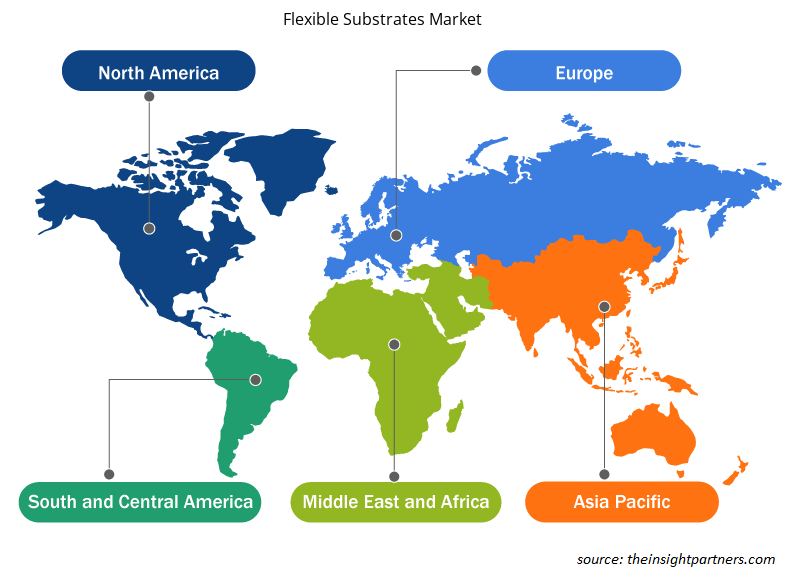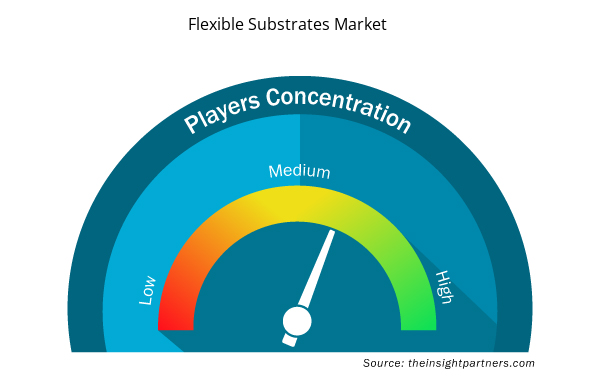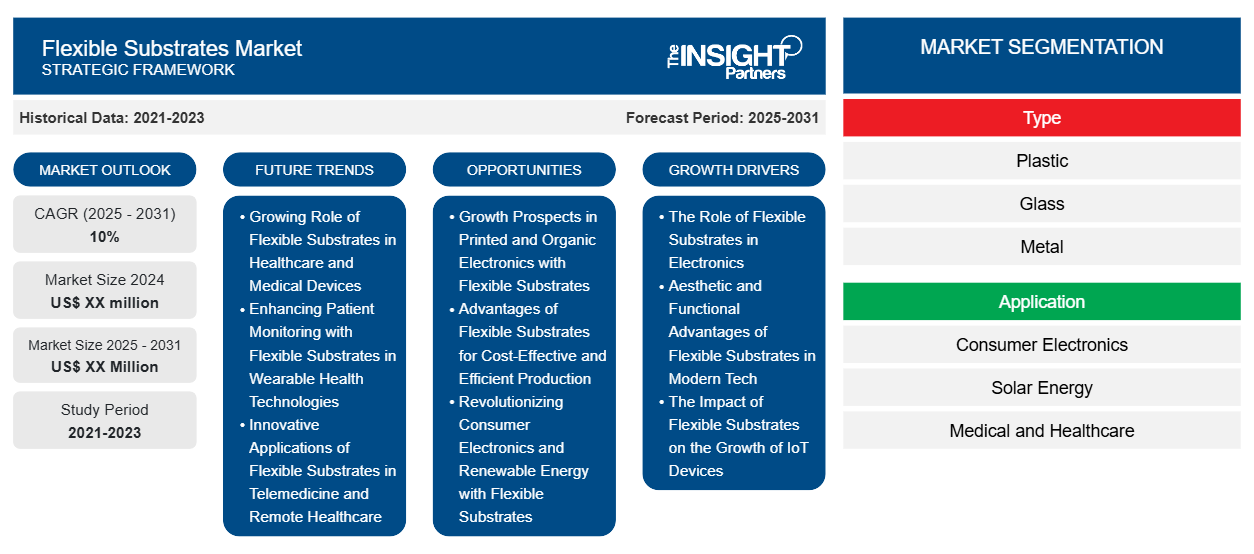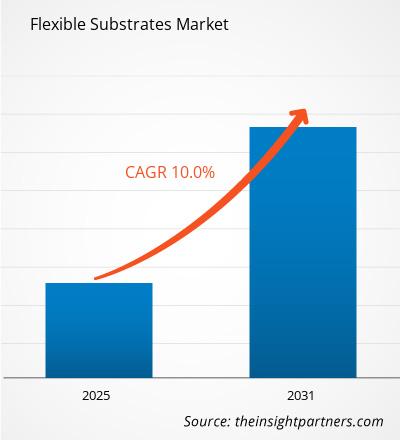Der Markt für flexible Substrate wird voraussichtlich von 2024 bis 2031 eine durchschnittliche jährliche Wachstumsrate (CAGR) von 10 % verzeichnen, wobei die Marktgröße von XX Millionen US-Dollar im Jahr 2024 auf XX Millionen US-Dollar im Jahr 2031 wachsen wird.
Der Bericht präsentiert Analysen nach Typ (Kunststoff, Glas und Metall). Der Bericht ist nach Anwendung segmentiert (Unterhaltungselektronik, Solarenergie, Medizin und Gesundheitswesen sowie Luft- und Raumfahrt und Verteidigung). Die globale Analyse ist weiter auf regionaler Ebene und nach wichtigen Ländern aufgeschlüsselt. Die Marktgröße und -prognose auf globaler, regionaler und Länderebene für alle wichtigen Marktsegmente werden im Rahmen des Berichts abgedeckt. Der Bericht bietet den Wert in USD für die oben genannte Analyse und die Segmente. Der Bericht bietet wichtige Statistiken zum Marktstatus der wichtigsten Marktteilnehmer und bietet Markttrends und -chancen.
Zweck des Berichts
Der Bericht Flexible Substrates Market von The Insight Partners zielt darauf ab, die aktuelle Landschaft und das zukünftige Wachstum sowie die wichtigsten treibenden Faktoren, Herausforderungen und Chancen zu beschreiben. Dies wird verschiedenen Geschäftspartnern Einblicke geben, wie zum Beispiel:
- Technologieanbieter/-hersteller: Um die sich entwickelnde Marktdynamik zu verstehen und die potenziellen Wachstumschancen zu kennen, damit sie fundierte strategische Entscheidungen treffen können.
- Investoren: Durchführung einer umfassenden Trendanalyse hinsichtlich der Marktwachstumsrate, der finanziellen Marktprognosen und der Chancen entlang der Wertschöpfungskette.
- Regulierungsbehörden: Zur Regulierung von Richtlinien und Überwachungsaktivitäten auf dem Markt mit dem Ziel, Missbrauch zu minimieren, das Vertrauen der Anleger zu bewahren und die Integrität und Stabilität des Marktes aufrechtzuerhalten.
Flexible Substrate Marktsegmentierung
Typ
- Plastik
- Glas
- Metall
Anwendung
- Unterhaltungselektronik
- Sonnenenergie
- Medizin und Gesundheitswesen
- Luft- und Raumfahrt und Verteidigung
Passen Sie diesen Bericht Ihren Anforderungen an
Sie erhalten kostenlos individuelle Anpassungen an jedem Bericht, einschließlich Teilen dieses Berichts oder einer Analyse auf Länderebene, eines Excel-Datenpakets sowie tolle Angebote und Rabatte für Start-ups und Universitäten.
- Holen Sie sich die wichtigsten Markttrends aus diesem Bericht.Dieses KOSTENLOSE Beispiel umfasst eine Datenanalyse von Markttrends bis hin zu Schätzungen und Prognosen.
Wachstumstreiber auf dem Markt für flexible Substrate
- Die Rolle flexibler Substrate in der Elektronik: Die steigende Nachfrage nach flexibler Elektronik ist ein großer Wachstumstreiber für den Markt für flexible Substrate. Verbraucher drängen auf leichtere, dünnere und vielseitigere Geräte, und flexible Substrate werden als einziger gangbarer Weg für Innovationen bei Smartphones, tragbaren Geräten und anderen tragbaren elektronischen Geräten angesehen. Der Trend geht dahin, das Design und die Funktionalität elektronischer Produkte neu zu gestalten und zu verändern.
- Ästhetische und funktionale Vorteile flexibler Substrate in der modernen Technik: Flexible Substrate öffnen die Türen für eine neue Kategorie der Technologieintegration, wie OLEDs und flexible Displays. Die Möglichkeit, verschiedene Formen zu erstellen, komplexe Krümmungen einzubringen und eine künstlerische Form oder Oberflächenstruktur zu schaffen, maximiert die Ästhetik und das Benutzererlebnis. Dies ist ein absoluter Vorteil für die Unterhaltungselektronik- und Automobilbranche, wo Designanpassung ein wichtiges Thema ist.
- Der Einfluss flexibler Substrate auf das Wachstum von IoT-Geräten: Auch im Internet der Dinge steigt die Nachfrage nach flexibler Elektronik. Die Weiterentwicklung von IoT-Geräten macht den Bedarf an leichten und langlebigen Substraten, die komplexe Funktionen ermöglichen, ausschlaggebend. Flexible Substrate ermöglichen in gewisser Weise Fortschritt, da sie eine robuste Plattform für Sensoren und Schaltkreise bieten, was zu einer deutlichen Expansion des Marktes führt.
Markttrends für flexible Substrate
- Wachsende Bedeutung flexibler Substrate im Gesundheitswesen und bei medizinischen Geräten: Flexible Substrate im Gesundheitswesen gehören zu den Trends, die zu zunehmendem Wachstum auf dem Markt führen werden. Medizinische Geräte wie tragbare Gesundheitsmonitore und diagnostische Sensoren verwenden zunehmend flexible Elektronik. Leichte, komfortable und anpassungsfähige Geräte nutzen Substrate, um die Patientenversorgung und -überwachung zu verbessern.
- Verbesserung der Patientenüberwachung mit flexiblen Substraten in tragbaren Gesundheitstechnologien: Tragbare Technologien revolutionieren das Gesundheitsmanagement durch Echtzeit-Erfassung von Vitalfunktionen. Geeignete flexible Substrate zur Ausführung einer Funktion, insbesondere in weichen oder tragbaren Geräten, gewährleisten die Zuverlässigkeit bei der Integration von Sensoren und Schaltkreisen. Dies gewährleistet die Tragbarkeit über ausreichend lange Zeiträume, um eine verbesserte Patienten-Compliance und Datengenauigkeit zu rechtfertigen.
- Innovative Anwendungen flexibler Substrate in der Telemedizin und der Ferngesundheitsversorgung: Darüber hinaus können flexible Substrate auch hochinnovative Anwendungen in der Telemedizin und der Ferngesundheitsversorgung haben. Da der Bedarf an Fernüberwachung von Patienten weiter steigt, steigt auch die Nachfrage nach effektiven und effizienten flexiblen elektronischen Geräten. Diese Substrate würden auch die Miniaturisierung von Komponenten unterstützen; so hätte man kompaktere Designs, die sich nahtlos in Alltagskleidung oder Accessoires integrieren lassen.
Marktchancen für flexible Substrate
- Wachstumsaussichten im Bereich gedruckte und organische Elektronik mit flexiblen Substraten: Da in der gedruckten und organischen Elektronik flexible Substrate zur Herstellung flexibler, leichter, kostengünstiger und umweltfreundlicher elektronischer Geräte verwendet werden, ergeben sich hieraus voraussichtlich enorme Wachstumsaussichten, da mit der steigenden Nachfrage nach umweltfreundlichen Lösungen in verschiedenen Bereichen Anwendungen entwickelt werden.
- Vorteile flexibler Substrate für eine kostengünstige und effiziente Produktion: Flexible Substrate eignen sich sehr gut für Anwendungen in der gedruckten Elektronik, da sie mit der Rolle-zu-Rolle-Fertigung kompatibel sind, einer Methode, die die Effizienz des Produktionsprozesses steigert, die Produktionskosten senkt und für die Massenproduktion flexibler Displays, Sensoren und RFID-Tags äußerst attraktiv ist. Aufgrund der zunehmenden Akzeptanz in verschiedenen Branchen besteht die Aussicht auf weiteres Wachstum.
- Revolutionierung der Unterhaltungselektronik und erneuerbarer Energien mit flexiblen Substraten: In der organischen Elektronik ermöglichten flexible Substrate Gerätekonzepte wie OLEDs und organische Photovoltaik, wobei ihr geringes Gewicht und ihre Flexibilität genutzt wurden, um neue Designs in der Unterhaltungselektronik und bei Lösungen für erneuerbare Energien dramatisch zu verändern. Die Zunahme intelligenter Verpackungen und Energiegewinnungstechnologien wird auf derselben Wellenlänge liegen.
Regionale Einblicke in den Markt für flexible Substrate
Die regionalen Trends und Faktoren, die den Markt für flexible Substrate während des gesamten Prognosezeitraums beeinflussen, wurden von den Analysten von Insight Partners ausführlich erläutert. In diesem Abschnitt werden auch die Marktsegmente und die Geografie für flexible Substrate in Nordamerika, Europa, im asiatisch-pazifischen Raum, im Nahen Osten und Afrika sowie in Süd- und Mittelamerika erörtert.

- Erhalten Sie regionale Daten zum Markt für flexible Substrate
Umfang des Marktberichts über flexible Substrate
| Berichtsattribut | Details |
|---|---|
| Marktgröße im Jahr 2024 | XX Millionen US-Dollar |
| Marktgröße bis 2031 | XX Millionen US-Dollar |
| Globale CAGR (2025 - 2031) | 10 % |
| Historische Daten | 2021-2023 |
| Prognosezeitraum | 2025–2031 |
| Abgedeckte Segmente | Nach Typ
|
| Abgedeckte Regionen und Länder | Nordamerika
|
| Marktführer und wichtige Unternehmensprofile |
|
Dichte der Marktteilnehmer für flexible Substrate: Die Auswirkungen auf die Geschäftsdynamik verstehen
Der Markt für flexible Substrate wächst rasant, angetrieben durch die steigende Nachfrage der Endnutzer aufgrund von Faktoren wie sich entwickelnden Verbraucherpräferenzen, technologischen Fortschritten und einem größeren Bewusstsein für die Vorteile des Produkts. Mit steigender Nachfrage erweitern Unternehmen ihr Angebot, entwickeln Innovationen, um die Bedürfnisse der Verbraucher zu erfüllen, und nutzen neue Trends, was das Marktwachstum weiter ankurbelt.
Die Marktteilnehmerdichte bezieht sich auf die Verteilung der Firmen oder Unternehmen, die in einem bestimmten Markt oder einer bestimmten Branche tätig sind. Sie gibt an, wie viele Wettbewerber (Marktteilnehmer) in einem bestimmten Marktraum im Verhältnis zu seiner Größe oder seinem gesamten Marktwert präsent sind.
Die wichtigsten auf dem Markt für flexible Substrate tätigen Unternehmen sind:
- TEJIN LIMITED
- Indorama-Unternehmen
- Kolon Industries, Inc.
- Corning Incorporated
- Polyonics, Inc.
Haftungsausschluss : Die oben aufgeführten Unternehmen sind nicht in einer bestimmten Reihenfolge aufgeführt.

- Überblick über die wichtigsten Akteure auf dem Markt für flexible Substrate
Wichtige Verkaufsargumente
- Umfassende Abdeckung: Der Bericht deckt die Analyse von Produkten, Dienstleistungen, Typen und Endbenutzern des Marktes für flexible Substrate umfassend ab und bietet einen ganzheitlichen Überblick.
- Expertenanalyse: Der Bericht basiert auf dem umfassenden Verständnis von Branchenexperten und Analysten.
- Aktuelle Informationen: Der Bericht stellt durch die Abdeckung aktueller Informationen und Datentrends Geschäftsrelevanz sicher.
- Anpassungsoptionen: Dieser Bericht kann angepasst werden, um spezifische Kundenanforderungen zu erfüllen und die Geschäftsstrategien optimal anzupassen.
Der Forschungsbericht zum Markt für flexible Substrate kann daher dabei helfen, die Branchensituation und Wachstumsaussichten zu entschlüsseln und zu verstehen. Obwohl es einige berechtigte Bedenken geben kann, überwiegen die allgemeinen Vorteile dieses Berichts tendenziell die Nachteile.
- Historische Analyse (2 Jahre), Basisjahr, Prognose (7 Jahre) mit CAGR
- PEST- und SWOT-Analyse
- Marktgröße Wert/Volumen – Global, Regional, Land
- Branche und Wettbewerbsumfeld
- Excel-Datensatz


- Public Key Infrastructure Market
- Intraoperative Neuromonitoring Market
- Aircraft Wire and Cable Market
- Water Pipeline Leak Detection System Market
- Blood Collection Devices Market
- Sexual Wellness Market
- Personality Assessment Solution Market
- Identity Verification Market
- Bathroom Vanities Market
- Enteral Nutrition Market

Report Coverage
Revenue forecast, Company Analysis, Industry landscape, Growth factors, and Trends

Segment Covered
This text is related
to segments covered.

Regional Scope
North America, Europe, Asia Pacific, Middle East & Africa, South & Central America

Country Scope
This text is related
to country scope.
Häufig gestellte Fragen
The adoption of flexible substrates in healthcare is expected to be the key market trends.
Based on type, the plastic segment is expected to witness the fastest growth during the forecast period
Based on geography, Asia Pacific held the largest share of the flexible substrates market due the region's strong electronics manufacturing base, particularly in countries such as China, Japan, and South Korea
The increasing demand for flexible electronics is driving the market growth.
Corning Inc.; Coveme Spa; Heraeus Deutschland GmbH and Co. KG; I-Components Co., Ltd.; Kolon Industries; Nippon Electric Glass Co., Ltd.; Polyonics; Rogers Corporation; Schott AG; and The 3M Company are some of the key players operating in the flexible substrates market
The Flexible Substrates Market is estimated to witness a CAGR of 10% from 2023 to 2031
Trends and growth analysis reports related to Chemicals and Materials : READ MORE..
The List of Companies
1. TEIJIN LIMITED
2. Indorama Corporation
3. Kolon Industries, Inc.
4. Corning Incorporated
5. Polyonics, Inc.
6. American Semiconductor, Inc
7. Nippon Electric Glass Co.,Ltd.
8. SCHOTT AG
9. i-components Co., Ltd.
10. BenQ Materials Corporation
The Insight Partners performs research in 4 major stages: Data Collection & Secondary Research, Primary Research, Data Analysis and Data Triangulation & Final Review.
- Data Collection and Secondary Research:
As a market research and consulting firm operating from a decade, we have published and advised several client across the globe. First step for any study will start with an assessment of currently available data and insights from existing reports. Further, historical and current market information is collected from Investor Presentations, Annual Reports, SEC Filings, etc., and other information related to company’s performance and market positioning are gathered from Paid Databases (Factiva, Hoovers, and Reuters) and various other publications available in public domain.
Several associations trade associates, technical forums, institutes, societies and organization are accessed to gain technical as well as market related insights through their publications such as research papers, blogs and press releases related to the studies are referred to get cues about the market. Further, white papers, journals, magazines, and other news articles published in last 3 years are scrutinized and analyzed to understand the current market trends.
- Primary Research:
The primarily interview analysis comprise of data obtained from industry participants interview and answers to survey questions gathered by in-house primary team.
For primary research, interviews are conducted with industry experts/CEOs/Marketing Managers/VPs/Subject Matter Experts from both demand and supply side to get a 360-degree view of the market. The primary team conducts several interviews based on the complexity of the markets to understand the various market trends and dynamics which makes research more credible and precise.
A typical research interview fulfils the following functions:
- Provides first-hand information on the market size, market trends, growth trends, competitive landscape, and outlook
- Validates and strengthens in-house secondary research findings
- Develops the analysis team’s expertise and market understanding
Primary research involves email interactions and telephone interviews for each market, category, segment, and sub-segment across geographies. The participants who typically take part in such a process include, but are not limited to:
- Industry participants: VPs, business development managers, market intelligence managers and national sales managers
- Outside experts: Valuation experts, research analysts and key opinion leaders specializing in the electronics and semiconductor industry.
Below is the breakup of our primary respondents by company, designation, and region:

Once we receive the confirmation from primary research sources or primary respondents, we finalize the base year market estimation and forecast the data as per the macroeconomic and microeconomic factors assessed during data collection.
- Data Analysis:
Once data is validated through both secondary as well as primary respondents, we finalize the market estimations by hypothesis formulation and factor analysis at regional and country level.
- Macro-Economic Factor Analysis:
We analyse macroeconomic indicators such the gross domestic product (GDP), increase in the demand for goods and services across industries, technological advancement, regional economic growth, governmental policies, the influence of COVID-19, PEST analysis, and other aspects. This analysis aids in setting benchmarks for various nations/regions and approximating market splits. Additionally, the general trend of the aforementioned components aid in determining the market's development possibilities.
- Country Level Data:
Various factors that are especially aligned to the country are taken into account to determine the market size for a certain area and country, including the presence of vendors, such as headquarters and offices, the country's GDP, demand patterns, and industry growth. To comprehend the market dynamics for the nation, a number of growth variables, inhibitors, application areas, and current market trends are researched. The aforementioned elements aid in determining the country's overall market's growth potential.
- Company Profile:
The “Table of Contents” is formulated by listing and analyzing more than 25 - 30 companies operating in the market ecosystem across geographies. However, we profile only 10 companies as a standard practice in our syndicate reports. These 10 companies comprise leading, emerging, and regional players. Nonetheless, our analysis is not restricted to the 10 listed companies, we also analyze other companies present in the market to develop a holistic view and understand the prevailing trends. The “Company Profiles” section in the report covers key facts, business description, products & services, financial information, SWOT analysis, and key developments. The financial information presented is extracted from the annual reports and official documents of the publicly listed companies. Upon collecting the information for the sections of respective companies, we verify them via various primary sources and then compile the data in respective company profiles. The company level information helps us in deriving the base number as well as in forecasting the market size.
- Developing Base Number:
Aggregation of sales statistics (2020-2022) and macro-economic factor, and other secondary and primary research insights are utilized to arrive at base number and related market shares for 2022. The data gaps are identified in this step and relevant market data is analyzed, collected from paid primary interviews or databases. On finalizing the base year market size, forecasts are developed on the basis of macro-economic, industry and market growth factors and company level analysis.
- Data Triangulation and Final Review:
The market findings and base year market size calculations are validated from supply as well as demand side. Demand side validations are based on macro-economic factor analysis and benchmarks for respective regions and countries. In case of supply side validations, revenues of major companies are estimated (in case not available) based on industry benchmark, approximate number of employees, product portfolio, and primary interviews revenues are gathered. Further revenue from target product/service segment is assessed to avoid overshooting of market statistics. In case of heavy deviations between supply and demand side values, all thes steps are repeated to achieve synchronization.
We follow an iterative model, wherein we share our research findings with Subject Matter Experts (SME’s) and Key Opinion Leaders (KOLs) until consensus view of the market is not formulated – this model negates any drastic deviation in the opinions of experts. Only validated and universally acceptable research findings are quoted in our reports.
We have important check points that we use to validate our research findings – which we call – data triangulation, where we validate the information, we generate from secondary sources with primary interviews and then we re-validate with our internal data bases and Subject matter experts. This comprehensive model enables us to deliver high quality, reliable data in shortest possible time.


 Holen Sie sich ein kostenloses Muster für diesen Bericht
Holen Sie sich ein kostenloses Muster für diesen Bericht